Do you want to amplify the sound of your harmonica but you don't know how? Are you indecisive about what kind of amplifier to select, prior performing on a stage or for the sake of sheer fun at home? Before connecting to your favorite e-commerce site and send an order, read this article.
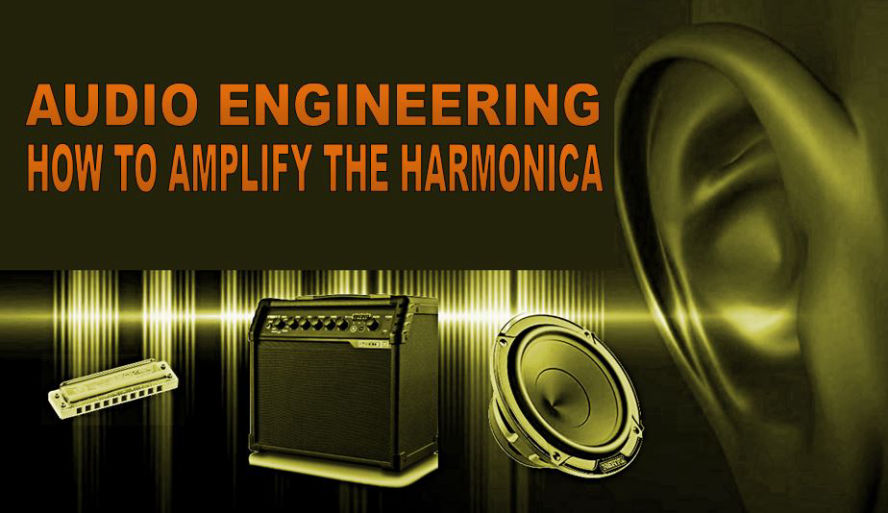
Today I'm going to talk about harmonica amplification, I'll share some general notions with you which are equally applicable to all audio appliances, and some very useful tips which you need to know before buying any sound diffusion system. We'll talk about sound, frequency response, loudspeakers, amplifiers. What else? Soon you'll get to know all about how to amplify your favorite instrument.
The harmonica is an acoustic instrument, and in order to get it amplified it should be played through a microphone. I will talk in depth about microphones in another article, so stay tuned on my website. You will find out how to 'pump' your harmonica to get your desired sound and above all, without spending a fortune. Exactly! You don't need much money to give volume to your little instrument, just learn which elements are important for the sound, and you can make targeted purchases that you won't regret. I can say it because, I've been there before!
Let's start by understanding what actually the sound is and what kind of sound your harmonica produces. The basis of every sound comprises of sound waves that have some characteristics including frequency. The higher the frequency, the more acute is the sound we hear. The human ear can theoretically perceive sound waves ranging from 20 to 20 thousand hertz. Hertz is the unit of measurement for frequency. In the picture below you will find a summary of the frequencies produced by several musical instruments. These are not the only frequencies emitted by them, because, as we'll see later the global sound we listen to, is also formed by some variation of the fundamental frequencies that are added to the basic one.
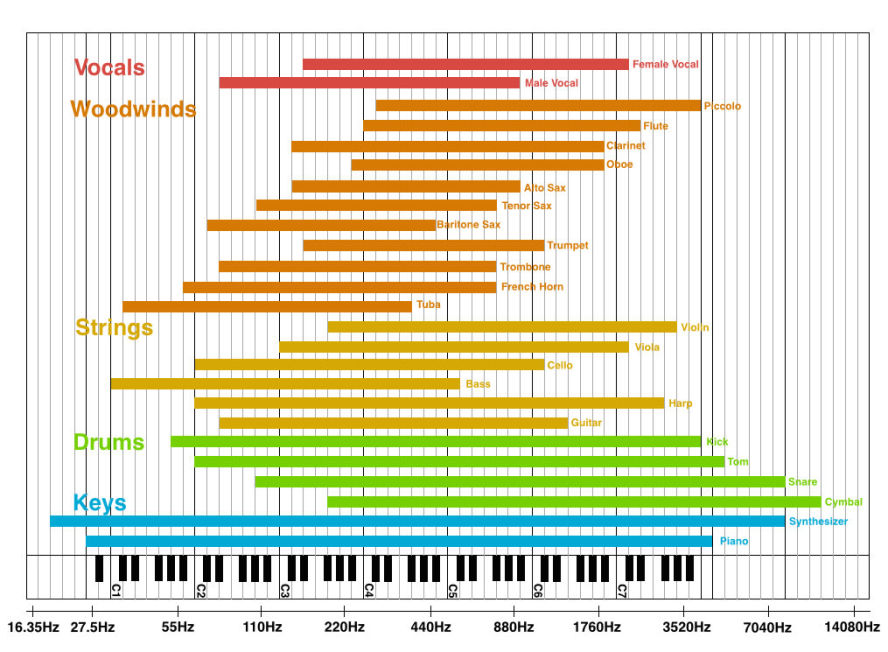
As shown in the figure each musical instrument emits sound waves that lie within a certain range: a bass guitar for example works between 40 and 450 hertz, while the piccolo is on the opposite extreme, emitting sounds ranging from 250 to 3600 hertz. These values are not to be taken as exact, but they give a good idea of what it means to play an instrument that produces low pitched sounds as compared to the one that emits high pitched sounds.
Where is the harmonica located within this range? The blues harp is quite versatile; depending on the key we choose it for, we will have deeper or more acute sounds. e.g. A low F harmonica will push more to the left on the frequency spectrum, while a standard F sharp harmonica will be very high. In general, however, the frequency spectrum would be wide, ranging from 300 to 10000 hertz perhaps even more. These values are due to the different harmonic waves that are produced when we play it, and as I said before, these are added to the basic frequency of the note chosen. You can see how this works in the next picture.
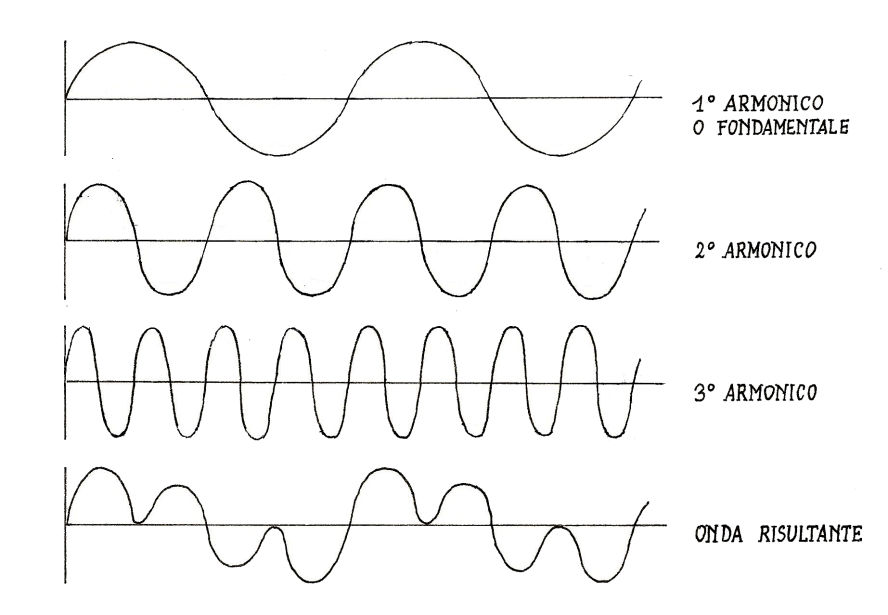
Now, if we want to amplify the sound we have to take into account that every object we interpose between the sound source and the ear, has some features including a frequency response. What does this mean? It means that in our case the harmonica will be played close to a microphone which, will be connected to an amplifier and in turn its amplified sound will be emitted by a loudspeaker; all these objects will determine the final result.
Let's take a look now at the first device in our audio chain: the microphone. A microphone for voice has a frequency response wider than a bullet harmonica microphone, this one in fact contains a capsule (element) similar to what we find in the old phones, can you recall how it sounded? Quite accentuated on medium frequencies, few bass and few treble. To give you some numbers, shure bullet 520DX microphone, well-known among harmonica players, has a frequency response ranging from 50 to 5000 declared hertz, which then turns into effective 400 to 4000 hertz. Based on this, you now know that this microphone cuts the frequencies emitted by your harmonica. If you click on the two links below, you can listen to the sound of a harmonica taken from a wide frequency response microphone, and compare it with the 5000 hertz cut from a capsule of the type described above. With the third link you can listen to the processed audio used to produce the famous 'Chicago sound'. This is achieved using a guitar amplifier, a device that emulates it, or with a software effect.
Harmonica sound cut at 5000 hertz.
Harmonica Chicago style sound.
Let's now turn to the loudspeaker: this object also has a frequency response. In particular, a large loudspeaker produces lower frequencies better than the ones which are higher. The subwoofer, woofer, midrange and the tweeter, all have specific characteristics that make them optimal for increasing frequency sounds. The tweeter is the one that best produces high frequency sounds. In the pictures below you can find examples of technical specifications of a woofer and a tweeter.
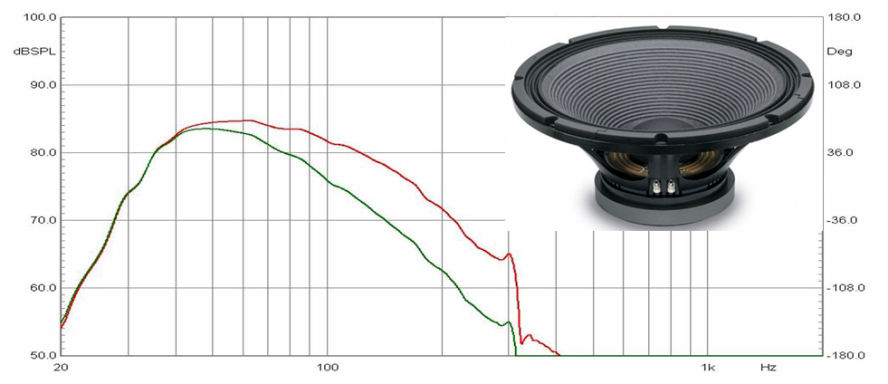
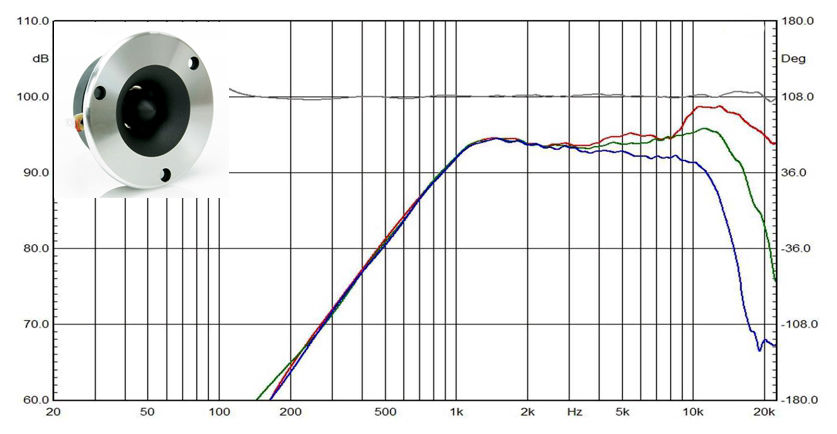
Continuing with our reasoning it is clear that if at the end of our audio chain we use a small speaker, we will remove other parts of the sound spectrum from our harmonica. The typical frequency responses of the different types of speakers are summarized below:
• Subwoofer (very low frequencies, usually below 50 Hz)
• Woofer (low frequencies - 50 Hz to 500 Hz)
• Midrange (medium frequencies - up to 0.5-8 khz)
• Tweeter (high frequencies - up to 8-18 khz)
• Supertweeter (very high frequencies - over 18 khz)
All we have discussed so far is to make you understand that in order to amplify a musical instrument, it is important to choose what kind of sound we want and how much of the original sound we want to retain. A 3-way loudspeaker system with a nice woofer, a midrange and a tweeter are genuinely suitable to reproduce what we play, where as a system with a single driver is bound to be compromising. Knowing this criterion we can decide what to use in order to meet our needs.
Okay, now you must be wondering; "What about the Chicago sound?" I know, many of us love the typical inflated and distorted harmonica that is shipped from United States: keep reading this article and you'll find out what you need to produce that kind of sound.
We will now analyze several amplification scenarios for the harmonica; for each of them, the necessary elements will be listed and I will explain how to connect them.
Amplification to reproduce a true sound:
We use a microphone with wide frequency response just like in case of a vocal mic which can be of both dynamic and condenser type. The microphone can be connected to a mixer and from there to a generic amplifier, or directly to an amplified speaker. We can also opt for a computer's sound card. There are several solutions; in principle this audio chain will not change the sound of the harmonica, however depending upon the equipment we interpose between the microphone and the speaker, we can equalize the sound or simply add effects. In this regard, I would like to clarify that with special effects and settings we can get all kinds of sound we want, including the 'Chicago sound'.
To give you an example, when I perform at venues I play guitar with harmonica and the harmonica is played directly in the microphone that I use for the voice. The signal enters the mixer and from there it goes to the speakers; harmonica sound and the voice both undergo same treatment.

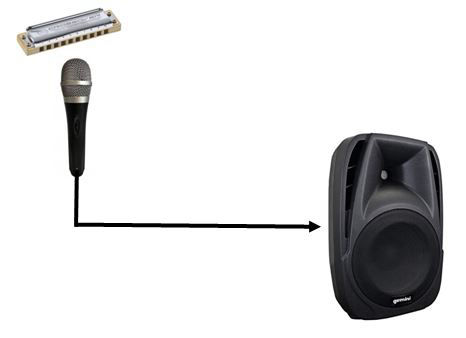
Specific amplification for Chicago-style sound:
For this type of sound we use a bullet-type high impedance microphone, and connect it directly to a guitar amplifier that comes in various types: there are tube amplifiers, transistor amplifiers (solid state), modeling (such as an emulation). With this type of amplifier you can engage various controls such as gain and tone, to get the desired type of sound. Often with this configuration you equalize the bass by increasing it to fill the sound of the harmonica. Not by chance, some pedals sold specifically for the harp have bass gain controls that can raise them by up to 20 decibels.
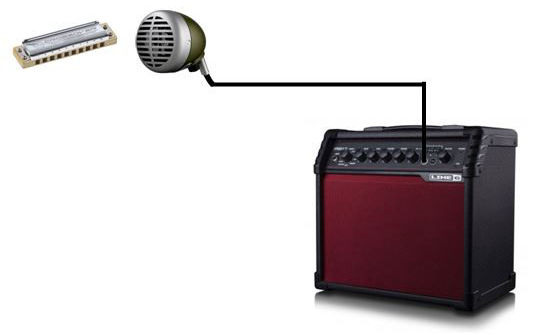
Another alternative to get this kind of sound is to use a high-impedance microphone, an amplifier emulator, and connect the output to any generic PA system.
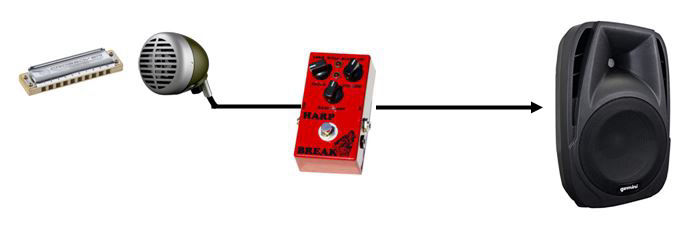

We have now come to the end of this article about amplification of a harmonica. I'm sure you will now have a clearer idea of what configuration can do for you, and I recommend you read the articles in-depth which you will find on my website about amplifiers, microphones and all the other gear for your small but great instrument. Good music!